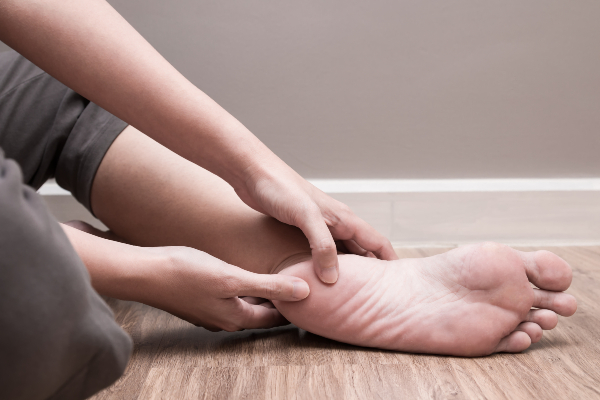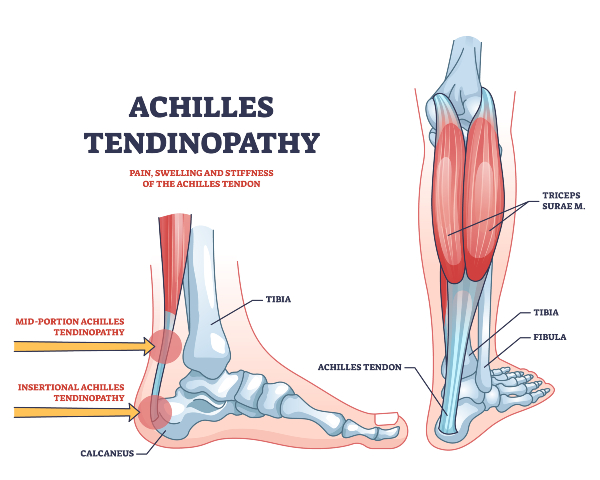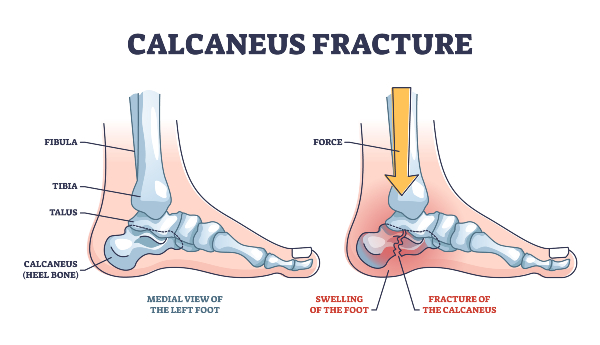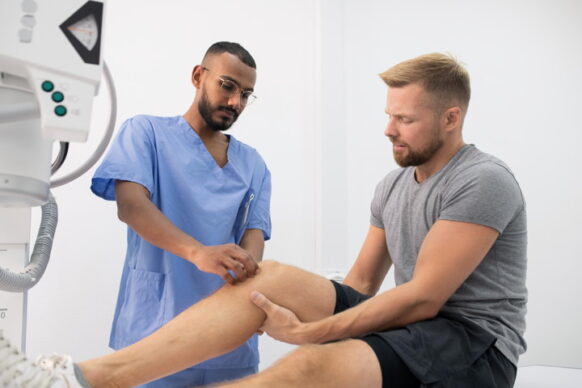Causes and Treatment of Heel Pain – Dr. John Chrabuszcz

Pain in the heel is a common problem. Depending on the location of the pain, the cause and treatment can vary. Causes of heel pain not caused by an obvious injury include Plantar Fasciitis, Heel Pad Atrophy, Insertional Tendonopathy/Haglund’s Syndrome, stress fracture of the Calcaneus, and in children, Apophysitis. Heel pain can cause issues with mobility and can make daily activities, work, and sports more difficult. Proper diagnosis and treatment are key to finding relief and moving more comfortably again. At OrthoGeorgia, our foot and ankle specialists have years of experience diagnosing and treating a wide range of conditions and injuries of the lower extremities, including heel pain. Learn more below about the causes of heel pain for those of all ages.
Plantar Fasciitis and Heel Pain

Plantar Fasciitis is the most common cause of plantar heel pain. The pain is on the plantar medial aspect of the heel. Pain on your first steps in the morning or after sitting for a long while is a common symptom.
While patients will occasionally recall an inciting event, the patient usually can not pinpoint a particular event or activity that caused his/her symptoms. Degenerative changes, chronic strain, or microrupture are accepted changes. There is an association with a tight heel cord or calf muscles. It is important to note that any associated heel spur is not the cause of the pain.
Treatment for Plantar Fasciitis
Treatment can consist of physical therapy including stretching, orthotics, immobilization, cortisone injections and, if all conservative treatment fails, surgery. Surgery for this entity usually is required in less than 5% of the patient population.
Heel Pad Atrophy

As we get older, fat pads can break down. Over time the protective cushion can be lost. Treatment for this condition is a heel cup or cushion.
Insertional Tendinopathy

Inflammation or degeneration of the Achilles tendon where it inserts on the calcaneus on the back of the heel is a source of posterior heel pain. It can be associated with spurring or bony prominences (exostosis) as well. Haglund’s Syndrome is a combination of insertional tendonitis, bursitis, and a large prominence (pump hump) on the back of the heel.
Diagnosis and Treatment of Insertional Tendinopathy
X-rays, even MRI, may be used to identify the pathology. Treatment can include heel lifts, immobilization, physical therapy, or surgery. Surgery can include debridement of the tendon, excision of all spurs and exostosis, and depending upon the extent of the damaged tendon, tendon transfers.
Stress Fractures of the Foot

Stress fractures can occur in the calcaneus. They are most often associated with an activity or an increase in activity level. They can also be associated with weight gain. While X-rays can often show the problem, very often bone scans or MRIs are necessary to identify the problem. Rest from activity and immobilization are recommended treatments.
Calcaneal Apophysitis as a Cause of Childhood Heel Pain

Pain at the posterior-inferior aspect of the heel in children is very often due to apophysitis, or inflammation of the growth plate. This can be due to overuse or tightness of the heel cord causing extra strain on this area. I often see this when a child starts a cleat sport.
Treatment of Calcaneal Apophysitis
Treatment includes stretching, heel lifts, modification of shoe gear, or immobilization if necessary. X-rays are usually taken to rule out other causes and sometimes, an MRI is necessary. Addressing this condition early can save the child from prolonged pain and allow him/her to return to their activity more comfortably.
About Dr. John Chrabuszcz

Dr. John Chrabuszcz is one of our Fellowship Trained orthopaedic surgeons at OrthoGeorgia, specializing in foot & ankle care. He is one of two Foot and Ankle Fellowship Trained Orthopaedic Surgeons in the Central Georgia region, and his areas of expertise include ankle instability, ankle arthritis, Achilles rupture, Achilles lengthening, and complex foot deformity correction. He has remained involved in his field over the years, having authored multiple research papers and medical journal articles on orthopaedic foot and ankle conditions. Dr. Chrabuszcz is a member of the Southern Orthopaedic Association, Medical Association of Georgia, Georgia Orthopaedic Society, Bibb County Medical Society, and American Academy of Orthopaedic Surgeons. He sees patients at our office in Macon, GA (Building A).
Orthopaedic Foot & Ankle Surgery and Care in Central GA at OrthoGeorgia
If you are experiencing heel pain or other foot & ankle symptoms that make it difficult to go about your daily life, we encourage you to schedule an appointment with an orthopaedic specialist at OrthoGeorgia. Our team will work with you from diagnosis to treatment, remaining by your side to support your recovery if surgery is needed. We will create a care plan unique to you and your specific anatomy and condition, while ensuring that all of your questions are answered along the way. Along with foot & ankle care, we also specialize in spine, hand & upper extremity, sports medicine, and total joint care. We work with patients at our offices in Macon, Macon Spine and Orthopaedic Center, Warner Robins, Kathleen, Milledgeville, Dublin, and Hawkinsville, GA. To learn more about how we can help you start living and moving more comfortably or to schedule an appointment at the location nearest you, please contact us at OrthoGeorgia today.

Personalized Orthopaedic Care in Central Georgia
At OrthoGeorgia, we want to help you live a healthier and more comfortable life by giving those in Macon, Warner Robins, Kathleen, Milledgeville, Dublin, Hawkinsville, and the surrounding areas convenient access to the highest quality care. Whether you have been suffering from a sports injury or a common orthopaedic condition, we will determine the cause of your discomfort and craft a personalized treatment plan to bring you relief. To learn more about our services and our physicians, or to schedule an appointment at OrthoGeorgia, please contact us today.







